
The Bottom Line
Introduction, Pricing & Detailed Look
I wrapped up my review on the Radeon RX Vega 64 by saying "I'm an enthusiast, and I wouldn't buy RX Vega", but wrapped up the final words with "Vega is great, it wishes to be, it just lacks the light to show AMD the way" and now it's 2019 when in comes the new Radeon VII which lays claim to landing multiple world-first achievements for gaming graphics cards.
AMD has just started off the year with a new enthusiast level graphics card launch with the Radeon VII, a surprise card that was announced in early-January during CES 2019. The new Radeon VII is a successor in sorts to the Radeon RX Vega 64 dropping the RX and Vega branding and landing with just VII.
VII can be interpreted in different ways: Radeon Vega II, or Vega II, but it is known as Radeon 7 with the VII being roman numerals. Radeon 7 is also great as AMD is leaping into the position of being the first gaming graphics card on the market on the 7nm node. NVIDIA's new Turing-based GeForce RTX cards are on 12nm while RX 500 series and RX Vega are on 14nm.
The surprise announcement at CES 2019 of the Radeon VII was surprising as I had internal sources tell me in late 2017 and early 2018 that there wouldn't be a "new Radeon" until 2019 when Navi lands.
I reached out to a few people and heard back that the Radeon VII won't be selling many cards at all, less than 5000 in total. Radeon VII with its 7nm Vega 20 GPU and 16GB of HBM2 closely resembles Radeon Instinct MI50 accelerator. NVIDIA is sitting at 12nm with Turing, while Polaris and Vega are made on 14nm. NVIDIA is expected to reach 7nm this year and more so in 2020 with Ampere, which we should hear more about this year, possibly at GTC 2019 next month.
I'm a big fan of enthusiast level hardware so the GeForce RTX 2080 Ti stands as my favorite graphics card before I tested the Radeon VII (and when I wrote this part of the review). 11GB of GDDR6 memory that hits 14Gbps and handles 4K without an issue, but can struggle at 8K as some games need more than 11GB of framebuffer.
16GB of HBM2 is a huge deal for super-enthusiast gaming at 8K resolution, on top of the world's first 7nm gaming GPU, is an exciting thing to do. I pinch myself each time I review a new graphics card like this as it's been a dream of mine.
Today is now 7nm GPU and 16GB HBM2 at 1TB/sec testing with Radeon VII, where I want to see just how good the temperature and power numbers are with the 7nm GPU over the 14nm-made Vega 10. The 16GB HBM2 at 1TB/sec will also be a huge strength for AMD at 4K and 8K testing, something I can't wait to dig my teeth into.
AMD's new Radeon VII is now on sale for $699.
Detailed Look
I'll give you a quick look at the card here, as I have a full unboxing article on the AMD Radeon VII that you're better off reading here.
7nm Node + Detailed Specs on Vega 20
AMD Is First To 7nm
AMD has been a leader in many technological leaps over NVIDIA more than once, with the Radeon VII continuing that tradition with it being the first gaming GPU on 7nm. The new Radeon VII has its Vega 20 GPU die smaller than the Vega 10 on Radeon RX 64, with twice the HBM2 memory on the interposer.
The shrink of the Vega GPU die down to 331mm2 from 495mm2 saves so much space that AMD added another two stacks of HBM2 which sees the Radeon VII featuring a huge 16GB of HBM2 memory at more bandwidth than ever before: 1TB/sec over the 512GB/sec of the 8GB of HBM2 on Radeon RX Vega 64.
Detailed Specs: Vega 10 vs Vega 20
AMD is calling its new Vega 20 GPU as a 'supercharged Vega architecture' with its industry leading 7nm process node and 16GB of ultra-fast HBM2 memory, all on the same interposer. This is a big deal, a very big deal compared to NVIDIA's way of making GeForce GTX/RTX cards with a separate GPU and VRAM.
Vega 20 is made on the 7nm node with 3840 stream processors, 60 CUs, and a GPU clock of up to 1.8GHz. We have up to 13.8 TFLOPs of compute performance as well, which combined with the 16GB of HBM2 makes for quite the content creation monster.
Vega 10 in comparison was made on 14nm with 64 CUs (4 CUs more than Vega 20), and 12.7 TFLOPs of performance. There was 8GB of HBM2 on a 2048-bit memory bus that resulted in 484GB/sec of memory bandwidth compared to the huge 16GB of ultra-fast HBM2 at 1TB/sec on Radeon VII.
Radeon VII has a 300W TDP offering much more performance than Radeon RX Vega 64 with a very similar 295W TDP.
The 16GB of HBM2 is ready on its 4096-bit memory bus for a whopping 1TB/sec of memory bandwidth.
We have similar transistor counts between Vega 10 and Vega 20 with the new Radeon VII with its 7nm-built Vega 20 GPU featuring 13.2 billion transistors versus the 14nm-made Vega 10 and its 12.5 billion transistors.
AMD managed to shrink this down so much moving from a 495mm2 chip in Vega 10 on 14nm to just 331mm2 on Vega 20, all with more performance and double the VRAM with double the bandwidth.
Vega 20 + 7nm: Enthusiast Performance
High Frame Rate 1440p + Smooth 4K Gaming
AMD really didn't have the best time with Vega its first iteration with the Radeon RX Vega 64 falling far from its hype and expectations, but that's not the case the second time around.
The new 7nm node and the additional wiggle room AMD has to play with in regards to GPU clocks and the faster HBM2 memory, we're looking at awesome performance for high frame rate 1440p 144/165Hz displays, 3440x1440 UltraWide monitors with 100-144Hz, and 4K 60Hz gaming monitors. This is a return to form for AMD and I love it. It doesn't best the RTX 2080 T i, but that's not what the Radeon VII represents.
If you're like me as a gamer and enthusiast, then you're a speed freak. I can't play games on anything less than a 100-120Hz display, so seeing 100/200/300FPS in charts from AMD, even in a game like Rainbow Six Siege, is another good thing to see. No more lukewarm Vega 64 performance, this is Vega 64 and some. Impressive stuff, AMD.
AMD is splitting gamers up properly into its performance gamers (which I believe should be Radeon RX 570, RX 580, and the 'new' RX 590 and not just the RX 590) and enthusiast gamers and creators, another nod towards Radeon VII being a creators-focused beast. Still, Radeon VII offers FreeSync 2 HDR support, 1440p and 100FPS+ in most games across AMD's own averages. Our benchmarks show similar results.
This is the type of gaming experience you'll only get on the Radeon VII, and maybe Vega 64 if you dropped some of the details. AMD says it perfectly 'premium gaming displays REQUIRE MORE PERFORMANCE".
Yes, yes they do.
16GB HBM2 - Breakthrough Bandwidth
16GB HBM2 @ 1TB/sec
There have been lofty expectations around HBM2 performance, but ultimately, AMD disappointed with the Radeon RX Vega 64. 8GB wasn't enough for the main argument, with NVIDIA having 11GB of RAM on the GeForce GTX 1080 Ti at the time, but the new HBM2 available on Radeon VII really amps things up.
AMD has a huge 16GB of HBM2 on the Radeon VII with a huge 1TB/sec of memory bandwidth thanks to its super-wide 4096-bit memory bus. AMD isn't aiming the Radeon VII at casual gamers, so the 16GB being fully utilized will be for a small handful.
I normally would have to explain this part but AMD provided a great infographic in the last 8 hours or so before the review went live. Here we can see that there are games on the market that consume up to 12.9GB of framebuffer. NVIDIA's closest competitor to the new Radeon VII is the GeForce RTX 2080 which has 8GB of GDDR6, compared to the larger 16GB of much faster HBM2 on the Radeon VII.
Most of these games combined have tens of millions of players, millions of which now have a Radeon graphics card capable of 4K 60FPS in most games, and the large 16GB VRAM to back it up. I will be exclusively running native 8K at 7680 x 4320 on my Dell UP3218K monitor in a follow up article in a couple of days, to see if we can really stretch out that 16GB of HBM2.
Content Creation Monster
16GB of ultra-fast HBM2 doesn't just accelerate games, it would better serve as a content creation monster where it can smash through 4K and 8K video encoding faster than ever before.
Adobe Premiere is used by millions of content creators, even here at TweakTown we're in it every day of the week. AMD's previous-gen Radeon RX Vega 64 was already a good card, but 8K editing isn't easy on a GPU... any GPU. The 16GB of HBM2 on the Radeon VII really comes in handy, offering up some good improvements over the RX Vega 64 and RTX 2080.
But when you look at compute performance in something like LuxMark, you really see how much that 16GB of super-fast HBM2 at 1TB/sec comes into play. We're looking at over 60% more results on the Radeon VII over the RX Vega 64 and RTX 2080 graphics cards.
Blender user? Yeah, you'll enjoy the Radeon VII too.
The same 30% or so improvement over the 8GB HBM2 inside of the Radeon RX Vega 64, and the same performance as the RTX 2080.
Test System Specs
Our New GPU Test Rig
Welcome to the latest revision of our GPU test bed, with our system being upgraded from the Intel Core i7-7700K to the Core i7-8700K. The CPU is cooled by the Corsair H115i PRO cooler, with the 8700K overclocked to 5GHz. We've stayed with GIGABYTE for our motherboard with their awesome Z370 AORUS Gaming 7.

We approached our friends at HyperX for a kit of their kick ass HyperX Predator DDR4-2933MHz RAM (HX429C15PB3AK4/32), with 2 x 8GB sticks for a total of 16GB DDR4-2933. The RAM stands out through every minute of our testing as it has beautiful RGB lights giving the system a slick look while benchmarking our lives away, while the Z370 AORUS Gaming 7 motherboard joins in with its own array of RGB lighting.
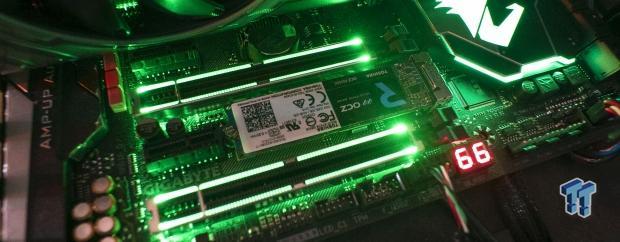
Detailed Tech Specs
- CPU: Intel Core i7-8700K @ 5GHz
- Cooler: Corsair Hydro Series H115i PRO
- MB: Z370 AORUS Gaming 7
- RAM: 16GB (2x8GB) HyperX Predator DDR4-2933
- SSD: 1TB OCZ RD400 NVMe M.2
- SSD: 512GB OCZ RD400 NVMe M.2
- PSU: InWin 1065W PSU
- Chassis: In Win X-Frame
- OS: Windows 10 Pro x64
Additional Images




Benchmarks - Synthetic
3DMark Fire Strike - 1080p
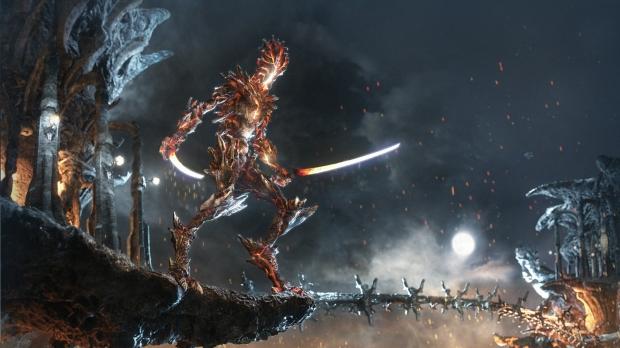
3DMark has been a staple benchmark for years now, all the way back to when The Matrix was released and Futuremark had bullet time inspired benchmarks. 3DMark is the perfect tool to see if your system - most important, your CPU and GPU - is performing as it should. You can search results for your GPU, to see if it falls in line with other systems based on similar hardware.

3DMark Fire Strike - 1440p
3DMark has been a staple benchmark for years now, all the way back to when The Matrix was released and Futuremark had bullet time inspired benchmarks. 3DMark is the perfect tool to see if your system - most important, your CPU and GPU - is performing as it should. You can search results for your GPU, to see if it falls in line with other systems based on similar hardware.
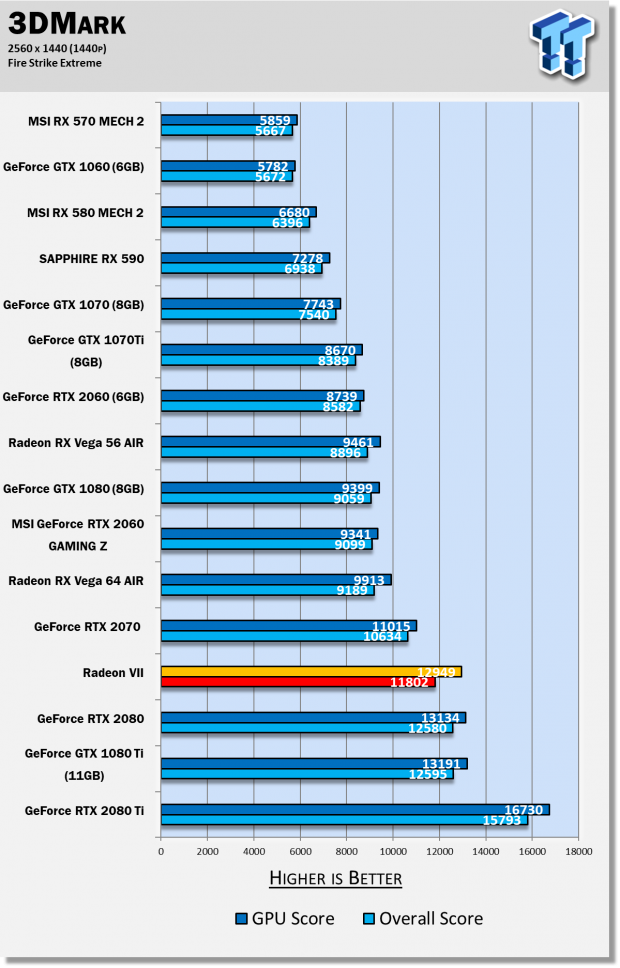
3DMark Fire Strike - 4K
3DMark has been a staple benchmark for years now, all the way back to when The Matrix was released and Futuremark had bullet time inspired benchmarks. 3DMark is the perfect tool to see if your system - most important, your CPU and GPU - is performing as it should. You can search results for your GPU, to see if it falls in line with other systems based on similar hardware.

3DMark TimeSpy


3DMark TimeSpy Extreme

Heaven - 1080p
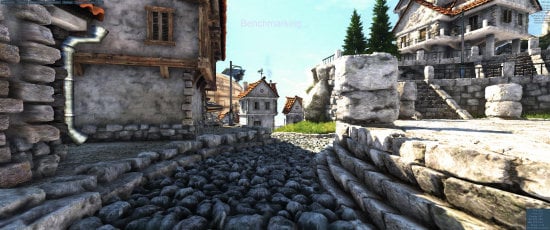
Heaven is an intensive GPU benchmark that really pushes your silicon to its limits. It's another favorite of ours as it has some great scaling for multi-GPU testing, and it's great for getting your GPU to 100% for power and noise testing.

Heaven - 1440p

Heaven - 4K
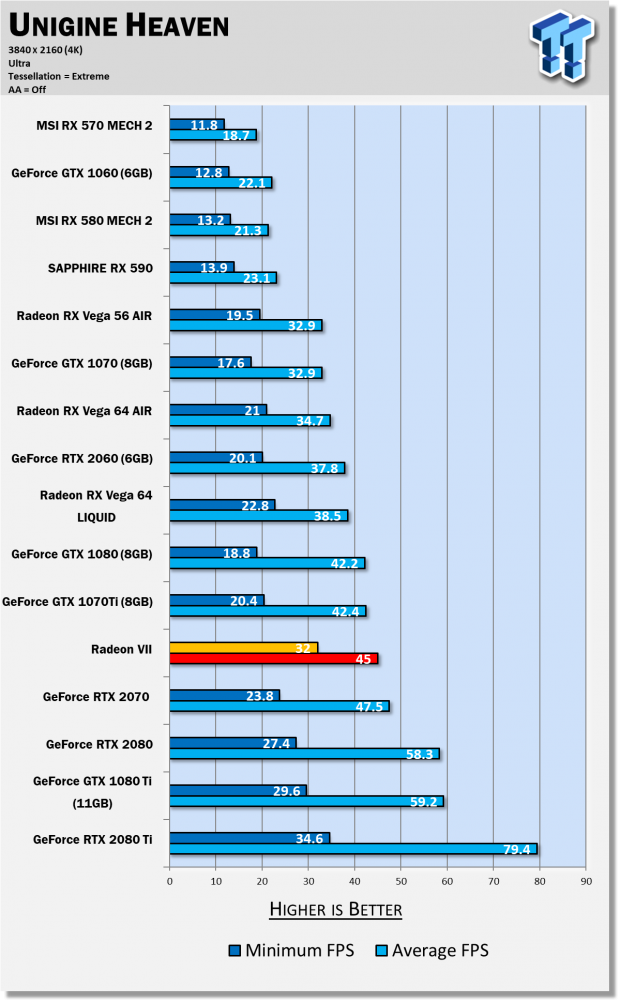
Benchmarks - 1080p
1080p Benchmarks

EA and DICE put everything they had into Battlefield V which runs the latest version of the Frostbite engine, and really stretches its legs in terms of graphics quality and squeezing the most from our cards. It's one of the best looking engines and best looking games on the market, until the new slew of games launches over the coming months, that is.
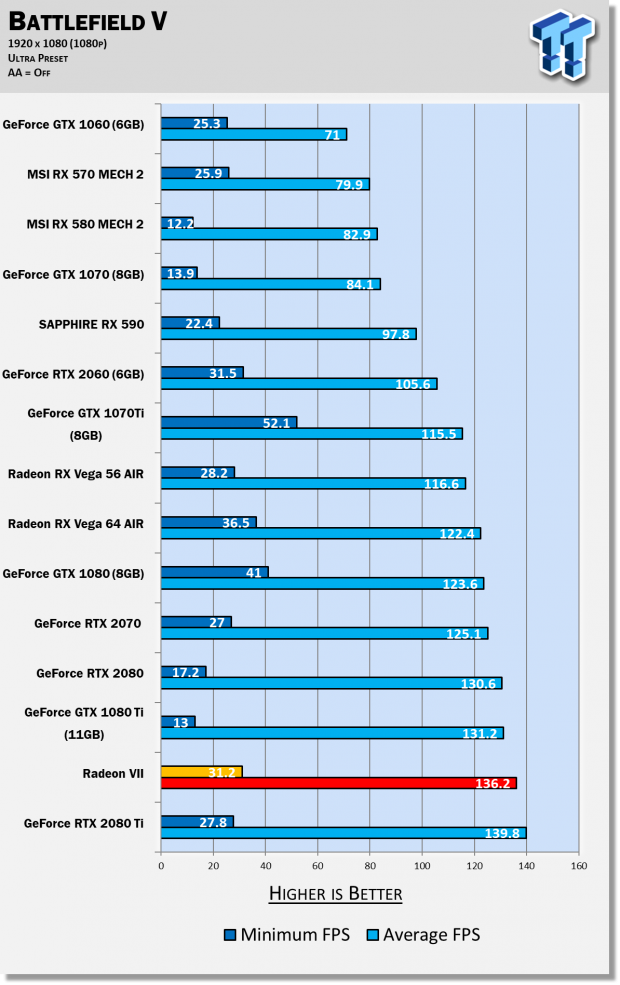
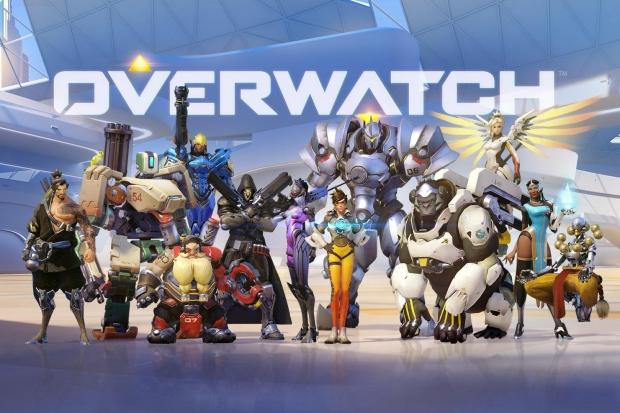
Overwatch is one of the most popular games on the market, from legendary game developer Blizzard. It's a game that looks great but doesn't require a huge amount of GPU grunt, but it's tested for another reason: high-FPS for enthusiast/professional gamers. Overwatch in our testing is to provide a two-fold result: first, it's a popular esports title and second it gives us a look at what we need to run it at 1440p for 144/165Hz displays and at 4K on those new 144Hz HDR G-Sync displays.


Middle-earth: Shadow of War is a sequel to the popular Shadow of Mordor, which was powered by the Lithtech engine. When cranked up to maximum detail, it will chew through your GPU and its VRAM like it's nothing.
You can buy Middle-earth: Shadow of War at Amazon.


Rainbow Six: Siege has been a strong entry into the franchise, popular for its realistic feel and great graphics. Stable as a rock for benchmarking, right up to 3440x1440 and 4K.


Metro: Last Light Redux comes from developer 4A Games, making the Redux version of Metro: Last Light the 'definitive' version of the game. Redux had a fresh coat of paint on the already impressive 4A Engine, and it really pushes our GPUs to their limits.
You can buy Metro: Last Light Redux at Amazon.


Far Cry 5 was developed by Ubisoft, and is powered the Dunia Engine, an engine that has been modified over the years for Far Cry. Dunia Engine itself was a modified version of CRYENGINE, scaling incredibly well on all sorts of hardware.
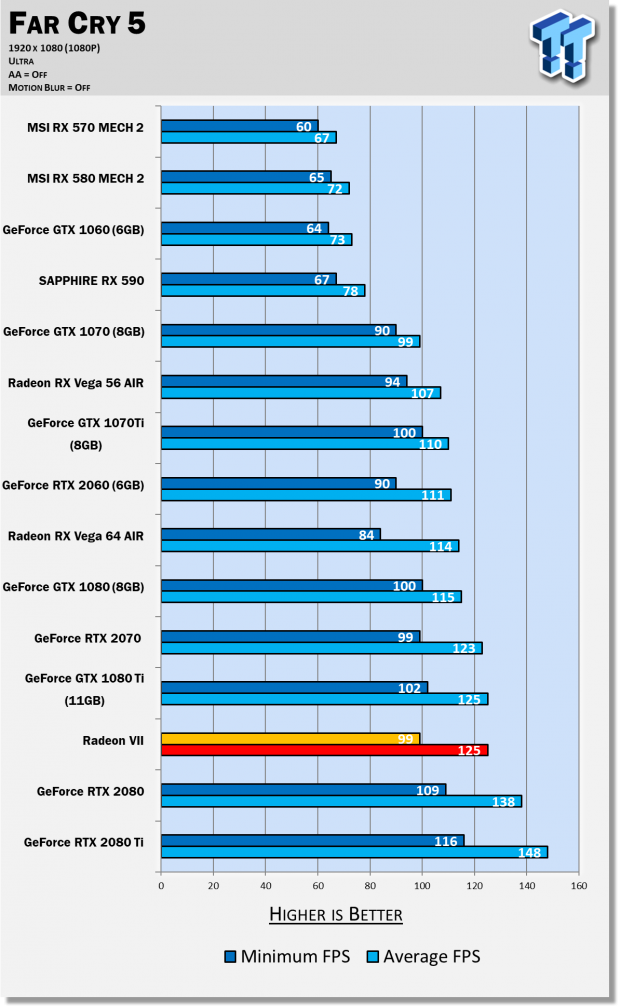

Shadow of the Tomb Raider is one of the latest games to join our graphics card benchmark lineup, with the game built using the Foundation engine as a base, the same engine in Rise of the Tomb Raider. Eidos Montreal R&D department made lots of changes to the engine during the development of Shadow of the Tomb Raider to make it one of the best-looking games out right now.

Benchmarks - 1440p
1440p Benchmarks

EA and DICE put everything they had into Battlefield V which runs the latest version of the Frostbite engine, and really stretches its legs in terms of graphics quality and squeezing the most from our cards. It's one of the best looking engines and best looking games on the market, until the new slew of games launches over the coming months, that is.


Overwatch is one of the most popular games on the market, from legendary game developer Blizzard. It's a game that looks great but doesn't require a huge amount of GPU grunt, but it's tested for another reason: high-FPS for enthusiast/professional gamers. Overwatch in our testing is to provide a two-fold result: first, it's a popular esports title and second it gives us a look at what we need to run it at 1440p for 144/165Hz displays and at 4K on those new 144Hz HDR G-Sync displays.


Middle-earth: Shadow of War is a sequel to the popular Shadow of Mordor, which was powered by the Lithtech engine. When cranked up to maximum detail, it will chew through your GPU and its VRAM like it's nothing.
You can buy Middle-earth: Shadow of War at Amazon.


Rainbow Six: Siege has been a strong entry into the franchise, popular for its realistic feel and great graphics. Stable as a rock for benchmarking, right up to 3440x1440 and 4K.


Metro: Last Light Redux comes from developer 4A Games, making the Redux version of Metro: Last Light the 'definitive' version of the game. Redux had a fresh coat of paint on the already impressive 4A Engine, and it really pushes our GPUs to their limits.
You can buy Metro: Last Light Redux at Amazon.


Far Cry 5 was developed by Ubisoft, and is powered the Dunia Engine, an engine that has been modified over the years for Far Cry. Dunia Engine itself was a modified version of CRYENGINE, scaling incredibly well on all sorts of hardware.


Shadow of the Tomb Raider is one of the latest games to join our graphics card benchmark lineup, with the game built using the Foundation engine as a base, the same engine in Rise of the Tomb Raider. Eidos Montreal R&D department made lots of changes to the engine during the development of Shadow of the Tomb Raider to make it one of the best-looking games out right now.
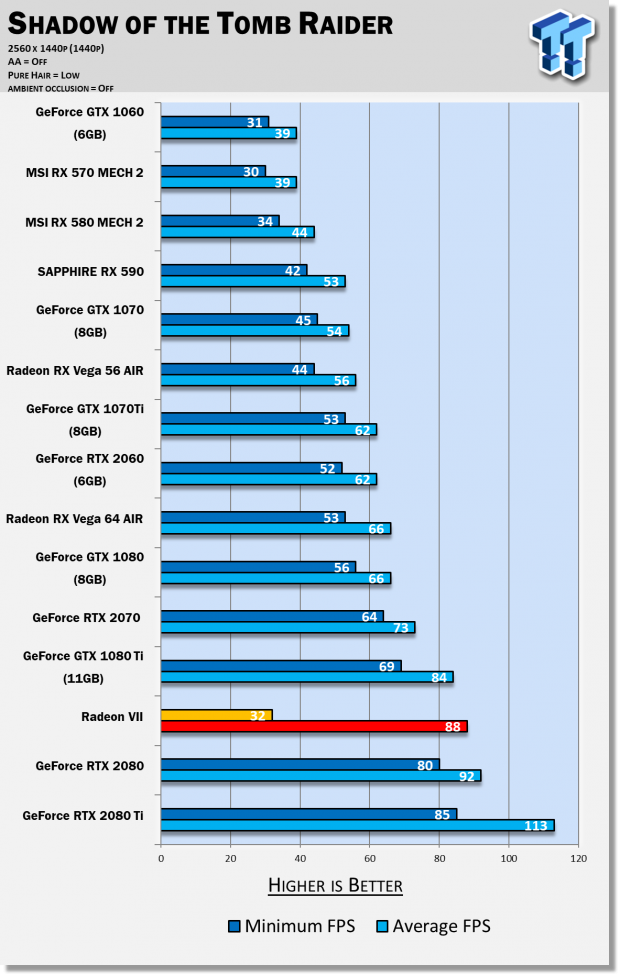
Benchmarks - 4K
4K Benchmarks

EA and DICE put everything they had into Battlefield V which runs the latest version of the Frostbite engine, and really stretches its legs in terms of graphics quality and squeezing the most from our cards. It's one of the best looking engines and best looking games on the market, until the new slew of games launches over the coming months, that is.


Overwatch is one of the most popular games on the market, from legendary game developer Blizzard. It's a game that looks great but doesn't require a huge amount of GPU grunt, but it's tested for another reason: high-FPS for enthusiast/professional gamers. Overwatch in our testing is to provide a two-fold result: first, it's a popular esports title and second it gives us a look at what we need to run it at 1440p for 144/165Hz displays and at 4K on those new 144Hz HDR G-Sync displays.


Middle-earth: Shadow of War is a sequel to the popular Shadow of Mordor, which was powered by the Lithtech engine. When cranked up to maximum detail, it will chew through your GPU and its VRAM like it's nothing.
You can buy Middle-earth: Shadow of War at Amazon.
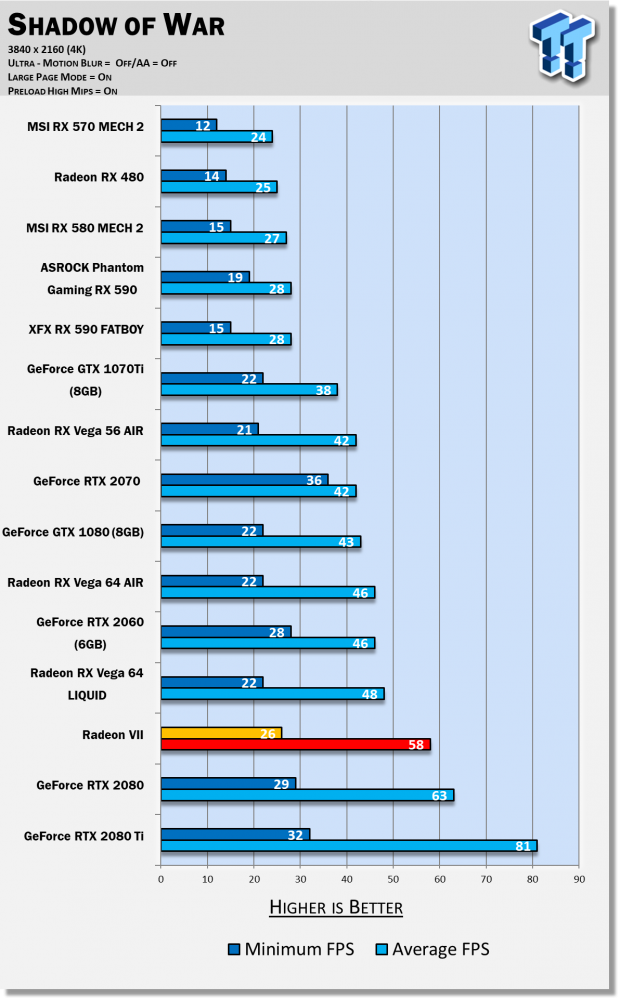

Rainbow Six: Siege has been a strong entry into the franchise, popular for its realistic feel and great graphics. Stable as a rock for benchmarking, right up to 3440x1440 and 4K.


Metro: Last Light Redux comes from developer 4A Games, making the Redux version of Metro: Last Light the 'definitive' version of the game. Redux had a fresh coat of paint on the already impressive 4A Engine, and it really pushes our GPUs to their limits.
You can buy Metro: Last Light Redux at Amazon.


Far Cry 5 was developed by Ubisoft, and is powered the Dunia Engine, an engine that has been modified over the years for Far Cry. Dunia Engine itself was a modified version of CRYENGINE, scaling incredibly well on all sorts of hardware.


Shadow of the Tomb Raider is one of the latest games to join our graphics card benchmark lineup, with the game built using the Foundation engine as a base, the same engine in Rise of the Tomb Raider. Eidos Montreal R&D department made lots of changes to the engine during the development of Shadow of the Tomb Raider to make it one of the best-looking games out right now.

Thermals, Power & Noise
Temperature

Power Consumption

Noise
I've talked about the loud cooler on the Radeon VII a few times throughout the review, but I'll say it again here - it definitely gets loud. All of NVIDIA's new GeForce RTX series cards don't get this loud at all, and the custom cards can be virtually silent. I will offset that noise with the power this card has over the Vega 64, as it's better to have a new Radeon card that competes with NVIDIA's enthusiast range of cards even if it does run louder than normal.
Performance Thoughts
AMD has really jumped up the benchmark charts with Radeon VII so much so that the $699 card becomes a viable choice for high-end Radeon gamers especially if they have a high refresh rate FreeSync gaming monitor.
The move to 7nm, higher GPU clocks on Vega 20, and radically increased memory bandwidth for its 16GB of HBM2 drive Radeon VII to GeForce RTX 2080 levels of performance, which is a big deal. Until now, Radeon RX Vega 64 was the flagship AMD graphics card and even when it was released it wasn't that great.
It barely had GeForce GTX 1080 levels of performance for the most part, and was hot and loud as well. Radeon VII is still hot and loud, but it gives you the performance that makes those two negative parts of the experience go away. NVIDIA's own GeForce RTX 20 series Founders Edition cards get hot and can be loud, but the power consumption numbers are far better.
AMD on the other hand is offering a 300W+ card that NVIDIA can match at 200-225W, at similar temperatures (60-75C) but the Radeon VII is definitely the loudest of them all. It's triple-fan cooler must be keeping the card cooler than if AMD went with a single-fan design, but by how much? Vega 20 and 16GB of HBM2 on a small interposer means there's a crap load of stuff going on in a small space, compared to the spaced-out use of GDDR5/5X/6 on NVIDIA's last two generations of GeForce graphics cards.
AMD's new Radeon VII allows the company to continue riding its success train from Ryzen to Threadripper to EPYC right into 2019 with Zen 2, Ryzen 3000 series, Ryzen Threadripper 3000 series, 7nm EPYC 'Rome' (64C/128T), the new Radeon VII and then all roads lead to Navi as we get closer to June/July.
I expect Navi to offer performance under the Radeon VII at $299-$599 with multiple cards in between that hit Radeon RX Vega 56/64 levels of performance but use GDDR6 and far better power consumption/temperature numbers.
Should You Buy It?
Content creators - This is a growing market for both sides: content creators, who are making content like videos during the day and want to game or whenever they're not using the PC for content-related purposes. Think of an animator or YouTuber by day who wants to crank out some rounds in PUBG, Overwatch, or Battlefield V.
They're going to want something to handle 1440p at 144Hz or 4K 60FPS and that's something AMD can finally, only just now with the Radeon VII - offer enthusiast level gaming to content creators.
Gamers - The fallout effect of this is only positive as gamers get a cracking graphics card, something that competes with not just the GeForce GTX 1080 Ti that launched in the same year as Radeon RX Vega 64, but performance that comes close to or competes with NVIDIA's latest GeForce RTX 2080 graphics card. That is a kick ass feat without launching a new GPU architecture.
Enthusiasts - You all know I'm an enthusiast - I've said it in all of my articles over the years that I want the absolute best. Right now I use two monitors: Dell UP3218K and the Acer Predator X27. We're talking native 8K (7680 x 4320) at 60Hz and a 4K 144Hz HDR G-Sync display. With this monitor you really want to match it with the best NVIDIA graphics card you can buy which is the GeForce RTX 2080 Ti.
Radeon VII gets to levels that you could comfortably play games like Overwatch and PUBG at 4K and over 120FPS when the time is right with FreeSync 2 gaming displays arrive, and they aren't far away. A bunch of companies started unveiling 4K 120Hz and beyond gaming displays but there wasn't a fast enough Radeon card to run it, until now. Radeon VII can handle that high 4K res and high refresh rate in the right games, which is another win for AMD and gamers.
Final Thoughts
AMD, you've really delivered with the Radeon VII. It might not be a planned release but it is big and loud enough to make an entrance and it stands as a huge flag planted firmly in 2019 for launching the world's first 7nm gaming GPU.
It's not a new GPU architecture, but the shift to 7nm has granted AMD enough room to create a much bigger beast in the Radeon VII. Being the first on 7nm is something that has AMD enjoying another technological win over NVIDIA, and double the fact since AMD is using much faster HBM2 on the Radeon VII with 1TB/sec of memory bandwidth. We're talking about doubling not just in the amount of memory, but memory bandwidth - all on a GPU that is smaller than the original Vega 10 and its 8GB of HBM2.
The 'supercharged' Vega GPU architecture and its 16GB of HBM2 propel it to performance levels that rival NVIDIA's new GeForce RTX 2070 graphics card, trading in the RTX abilities for the larger and faster 16GB of HBM2. If you don't plan on playing games with real-time ray tracing, DLSS or other NVIDIA features and technologies, the Radeon VII is a fine choice from AMD.
If you're a content creator by day and a gamer by night and the 8GB framebuffer on the RTX 2070, RTX 2080, or Vega 56 and Vega 64 aren't enough. AMD has planted 16GB of even faster HBM2 memory on Radeon VII which will provide more compute performance for content creation but it's not a lazy, lower-performing card when it comes to gaming. AMD is kicking ass and taking names when it comes to this one-two punch attack with Radeon VII.
So... performance is great. 16GB of HBM2 is great. Vega 20 on 7nm is great. Free games is also great.
What are the downsides?
It's loud... like, really loud. I was talking with Rob Williams (a great friend of mine, one of the best in not just the industry but the world - he is an awesome guy, and you should check out his site and his review on the Radeon VII right here) about this in the home stretch of writing our Radeon VII reviews. He asked if I thought it was loud and I said yeah it was, and he confirmed what I experienced: loud fans even in the menus of games. Not the game, but the fans spin up in the main menus rather quick.
In comparison, none of my NVIDIA cards do this in both the GeForce GTX 10 series and GeForce RTX series cards. AMD's older Radeon RX Vega cards get loud but not in the game menus that quick. The only other niggly bit here is that it gets rather warm, even with its improved cooler and triple-fan rig. Vega is just a hot-running GPU no matter what node (14nm or 7nm) and I think that's not something that'll change with Radeon cards until Navi.
AMD is asking $699 for its new Radeon VII which is a great price considering what card you're getting: a bleeding edge GPU on 7nm, and a huge (and expensive) 16GB of super-quick HBM2. There's also the three games that AMD is throwing in for free which is not a bad deal at all. Sure, you can get the GeForce RTX 2080 for $699 but they do scale upwards of $800-900 on Amazon at the time of writing.
If you need a new gaming monitor to go with your new Radeon VII graphics card, then you're in luck as FreeSync gaming displays are way cheaper than G-Sync monitors. The savings here alone can be hundreds of dollars depending on the display, so you can offset some of the loss of RTX features if you're not going to use them, in the Radeon VII and cheaper and very compatible FreeSync 2 gaming display.
So what happens now with Radeon now that we have the Radeon RX 590 and Radeon VII graphics cards?
Radeon RX Vega isn't really pushed anymore, which will lead us to the release of Navi. I think we'll see a few different Navi SKUs released that will hit price points of between $399 and $599, at $100 intervals from RX 590 at $289. The Radeon RX Vega 56 and 64 can be retired with similar or better performing cards that use GDDR6 memory and are much better on thermals (Navi will be on 7nm) and power consumption (because it's not Vega).
AMD's next step in the enthusiast world will be their next-gen GPU architecture after Navi which will be a truly big step in a new direction as it'll be the first GPU architecture since GCN launched in 2011. We've had a bumpy ride with the GCN architecture over the years, where GCN started out as a graphics card first approach before AMD went towards semi-custom and the GPU architectures were created as products for Apple (Vega) and Microsoft and Sony (Polaris) for the Xbox and PlayStation consoles.
The same is happening with Navi in our exclusive report that said the next-gen PlayStation 5 console will be powered by the Navi GPU architecture. Sony worked directly with the RTG engineers on the Navi GPU architecture, which means it's another console-derived chip that will be made into a graphics card. Don't expect Navi to come knocking down the Radeon VII as it'll be the highest-end card that AMD will offer this year.
We should start hearing about the new GPU architecture from AMD in 2020, which will need to compete with the new Intel GPUs that will be launching, and NVIDIA shifting down to the 7nm node - and will include its next-gen Ampere GPU architecture. 2020 is going to be an absolutely huge year for the GPU market with both AMD and NVIDIA taking the fight to another level with new releases and GPU architectures, as well as Intel entering the game with most of the ex-RTG team at the helm at a time when its CPU division is going through tumultuous times.
We shouldn't expect to see millions of Radeon VII cards sold and that's for a few reasons: 7nm isn't in massive numbers yet, HBM2 is still expensive and being chewed up by the enterprise/deep learning/AI markets, and AMD's fight is better fought in the mainstream market where Navi will be soon. Radeon VII is a flashy new release that if its performance wasn't there, would be near game over for AMD's high-end graphics cards.
But Radeon VII is not that, it has kick ass performance for the money this time around.
For now, AMD has released a formidable new card in the high-end/enthusiast space that has a few sore spots - but other than that, it's a kick ass release from AMD that brings them back to the high-end graphics card space. Forget the taste that Vega 56 and 64 left in our mouths, and take a look at Radeon VII. It's a huge improvement in virtually all ways, and deserves the praise it will get.
It comes at a time when lots of gamers aren't happy with NVIDIA over the pricing of the GeForce RTX series, so now they have a new alternative with Radeon VII - something AMD didn't offer until now. Great work, and great timing, AMD. Kudos for the surprise and great release of the Radeon VII.
Now... all roads for Radeon lead to Navi...

| Performance (overclocking, power) | 95% |
| Quality (build, design, cooling) | 90% |
| General Features (display outputs, etc) | 90% |
| Bundle, Packaging & Software | 90% |
| Overall | 91% |
The Bottom Line: AMD re-enters the high-end/enthusiast GPU race once again with its new Radeon VII, the world's first 7nm gaming GPU that packs a huge 16GB of super-fast HBM2. It trades blows with the GeForce RTX 2080 which is a big deal, #TeamRed is back and swinging.
PRICING: You can find products similar to this one for sale below.
 United
States: Find other tech and computer products like this
over at Amazon.com
United
States: Find other tech and computer products like this
over at Amazon.com
 United
Kingdom: Find other tech and computer products like this
over at Amazon.co.uk
United
Kingdom: Find other tech and computer products like this
over at Amazon.co.uk
 Australia:
Find other tech and computer products like this over at Amazon.com.au
Australia:
Find other tech and computer products like this over at Amazon.com.au
 Canada:
Find other tech and computer products like this over at Amazon.ca
Canada:
Find other tech and computer products like this over at Amazon.ca
 Deutschland:
Finde andere Technik- und Computerprodukte wie dieses auf Amazon.de
Deutschland:
Finde andere Technik- und Computerprodukte wie dieses auf Amazon.de
What's in Anthony's PC?
- CPU: Intel Core i5-12600K
- MOTHERBOARD: GIGABYTE Z690 AERO-G
- RAM: Corsair 32GB DDR4-3200
- GPU: NVIDIA GeForce RTX 4090 24GB
- SSD: Sabrent 4TB Rocket 4 Plus
- OS: Windows 11 Pro
- CASE: Lian Li O11 Dynamic XL
- PSU: ASUS ROG Strix 850W
- KEYBOARD: Logitech G915 Wireless
- MOUSE: Logitech G502X Wireless
- MONITOR: LG C3 48-inch OLED TV 4K 120Hz
Similar Content
Related Tags




























